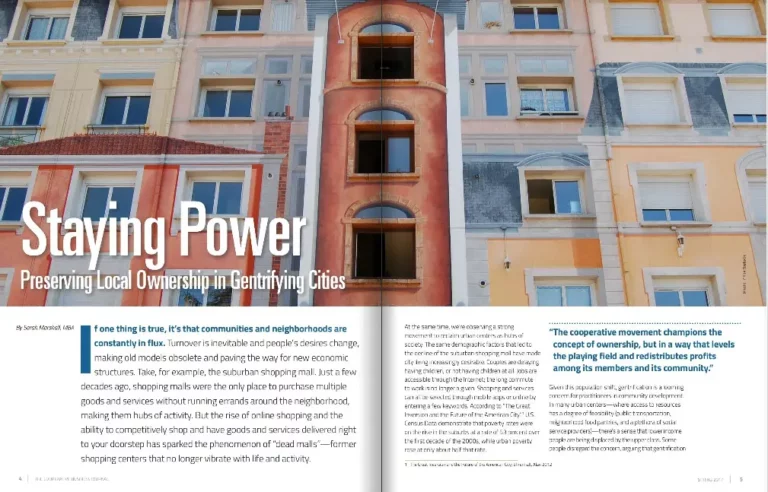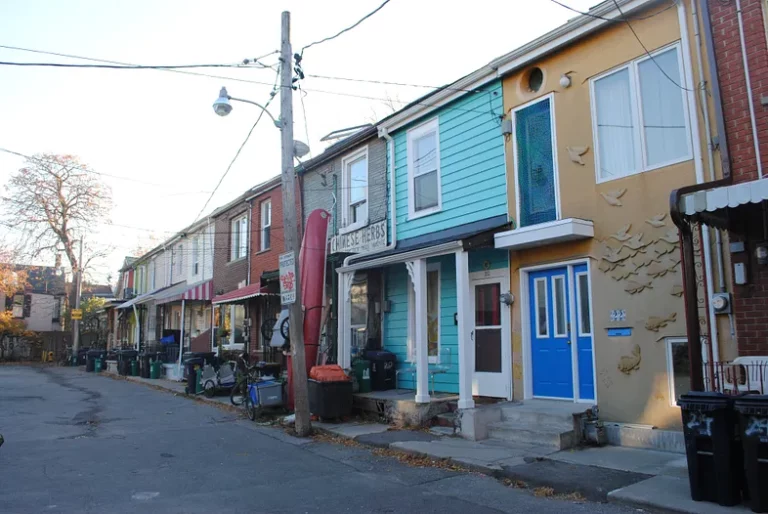Reckoning with Digital Inequity in Place-Based Community Revitalization
Abstract
Place-based community development in America has a rich history. Practices and procedures for successful redevelopment are supported by lobbying efforts, public administration, policy, federal funding, and the efforts of non-profits dedicated to neighborhood revitalization. Community revitalization work is often centered around specific geographic locations, while in recent decades modern technology has caused social networks to become increasingly geographically disparate. Social networks have been demonstrated to support the economic mobility that community development strives to create. However, the impact of modern technology on place-based community development has not been clearly understood. Increasing digitalization has impacted the effectiveness of place-based social equity efforts such as community organizing, affordable housing and economic development, and financial capability interventions. This essay explores how place-based community organizing led to the creation of current policies that govern community development, how technology has impacted urban communities and how these changes may subsequently affect social equity objectives in public administration.
Introduction
Community revitalization work in the United States has historically been centered around geography. Policy and federal funding support community development, but many community revitalization levers were developed before the digital era. As a result, many strategies for poverty intervention prioritize a place-based approach. However, information and communication technologies (ICT) have allowed social networks to become geographically disconnected over recent decades. Social networks are now less likely to be place-based, although social networks have been demonstrated to support the economic mobility the community development field strives to create.
This essay explores how place-based community organizing led to the creation of current policies that govern community development, how technology has impacted digital inequities in urban communities and how these changes may subsequently affect social equity objectives in public administration. In this essay, community development is defined as work designed to improve social equity for individuals and communities living with incomes below 80% of the area median income. Likewise, technology refers to ICT and algorithms, data analytics, surveillance technology, automation, and artificial intelligence (i.e., big data).
The History of Community Development Lending
The relationship between the financial services industry and economic development is complex but is rooted in the history of the Community Reinvestment Act (CRA), a legislation passed in 1977. CRA was instituted as the result of grassroots organizing initiated in the Austin community area of Chicago. When residents noticed patterns of redlining by local banks, they formed an interracial coalition known as the Organization for a Better Austin (OBA) to bring about change (Marchiel, 2020). The practice of redlining led to neighborhood disinvestment, White flight, blockbusting, restrictive racial covenants, and other practices that contributed to the racial wealth gap between White and Black households that stood at a factor of ten times difference in 2020 (Brookings Institute, 2020).
These local issues were simply a prototype of similar activity in urban neighborhoods across the country. OBA formed National People’s Action (NPA), one of the first national coalitions of community organizers, to help organizers take their demands to the federal level (Marchiel,2020). The coalition lobbied for two actions, both of which were passed by Congress. In 1975, the Home Mortgage Disclosure Act (HMDA) was the first coalition victory. HMDA required mortgage lenders to make loan distribution data publicly available. Although HMDA did not have an enforcement mechanism, it gave OBA and NPA the tools necessary to prove patterns of discrimination (Marchiel, 2020). The coalitions next introduced CRA, brought to Congress by Senator William Proxmire (Marchiel, 2020). CRA required bank accountability to the local community in the form of investments, loans, and service. The policy appealed to government officials who saw CRA as a path to revitalize communities without federal spending. CRA uniquely relied on local, place-based organizing to maintain pressure on local banks to be most impactful.
The Act led to the inflow of funding to community lenders and non-profits that served disinvested communities and codified the relationship between financial institutions and community revitalization. Billions of dollars have passed between banks and community lenders as a result. CRA required banks to demonstrate they were lending to all segments of its assessment area. One of the three measures banks must pass is a lending test, but lending activity can be passed to a non-profit lender in the form of investments. Between 1977 and 1991, $8.8 billion in CRA credit agreements were formalized between banks and community organizations (Von Hoffman, 2012). The ideology that the private sector could be just as, or more effective in moving resources to low-income communities than the federal government led to another wave of grassroots organizing that established the Community Development Financial Institution (CDFI) Fund in 1994.
The CDFI Fund sits within the US Treasury. The Fund certifies mission-focused lenders and offers federal funding opportunities for lending to low-income or minority communities. It has enjoyed bipartisan support and encompasses a range of programs focused on community development finance. By 2017, over one thousand institutions were CDFI-certified and held collective assets above $130 billion (Rosenthal, 2018). Banks make an estimated $500 billion in CRA investments annually (Snyder, 2021). Portions of CRA money are routed through CDFIs to underserved communities. Today, technology has enabled community lenders to reach further, access geographically disparate markets, and expand their own footprints. But more capacious work is not equivalent to more effective work. Effective work requires considering how technology has changed the dynamics in communities as well.
The Rise of Technology and Digital Inequity
The term ‘community’ was predominately defined as one’s geographic location before the Industrial Revolution. Humans formed relationships based on proximity. Every form of technology has been disruptive to local relationships in some manner. The airplane, vehicle, telephone, television, and radio each expanded our physical boundaries. But even with these earlier technologies, barriers to maintaining distant relationships were high. No form of technology has had the radical impact of ICT, followed by applications of big data. Unlike other forms of technology, eventually it connected us to people around the world for a relatively low cost. However, the ubiquity of the internet has not led to the achievement of equity in American society.
A very real digital divide exists. It is traditionally defined as the gap in access between groups that have access to basic technology tools such as broadband internet and a home computer, and those that do not. A 2021 Pew Research study found barriers to broadband access still exist. Broadband access is reduced in predominately minority, and/or low-income communities and among seniors (Pew Research, 2021). Much work, initiated by a range of organizations from corporations, small non-profits, and government agencies, has sought to correct the inequities. In 2016, the Department of Housing and Urban Development (HUD)passed a final rule determining that new constructions or significant rehabilitation work of HUD-financed multi-family housing structures will require installation of broadband infrastructure (Federal Register, 2016). The passage of this rule ensures families living in HUD affordable housing will have the ability to get connected to a fast internet connection. The legislation recognizes internet access as a necessity. Without interventions, the most financially vulnerable Americans are poorly equipped to advance socioeconomically in a highly connected society.
Social Capital’s Role in Improving Economic Mobility
Technology’s impact is pervasive. Another type of digital divide exists that impacts the ways we interact with our neighbors, effects our expectations, and influences the ways in which communities interact. This divide is extant, but not visually observable. Although big data and ICTs are now nearly omnipresent in society, its impacts and effects are harder to articulate. Researchers have referred to this divide as the ‘second digital divide’ (Elesh & Zhao, 2007), and pertains to ICT usage. Elesh and Zhao (2007) highlight the importance of recognizing the capability of ICT in reinforcing existing social capital. In equity work, it is critical to recognize the social context in which big data and ICT are being used or implemented. Unequal social contexts generate unequal digital access and results. The second layer of the digital divide ispredicated on reinforcing social networks. Elesh and Zhao’s critique of social inequities that perpetuate digital inequities must be expanded upon. The technology sector has gainedoutsized influence in society. Leaders and personnel of large technology companies may never have been to your neighborhood, but through access to granular detail about our lives, data warehouses hold more information about what happens in every community than any individual ever will. What it means to be in community has been reshaped by the forces of ICT and big data.
Extensive scholarship has been conducted on the correlation between a person’s zip code and potential for economic mobility. Availability of social capital is determined by where one resides. The popular sociological book Bowling Alone: The Collapse and Revival of AmericanCommunity defines social capital as, “connections among individuals—social networks andthe norms of reciprocity and trustworthiness that arise from them” (Putnam, 2001, p. 19). The strength of the network also matters. The state of being well connected is not the sole differentiator for upward mobility; being connected in a network that is connected to resources is what matters (Putnam, 2001). Social capital is self-perpetuating. People in disconnected physical communities often end up struggling to achieve full economic potential, and a community may wrestle with persistent poverty. Poverty is inseparable from geography. While individuals may be poor in isolation, one person living in conditions of poverty does not a disrupt the social and material capital found in a well-connected neighborhood.
Local civic participation and social capital were once interlinked. Over two decades ago, Warren (2001) wrote, “Local elites that used to gain career-enhancing prestige from theirleadership of civic life in their communities now work for companies more tied to the globaleconomy than their localities” (p. 37). Now, working professionals use social media platforms such as LinkedIn to cultivate profitable relationships by engaging with the site’s data sets, search capabilities, and algorithmic suggestions. Social capital still matters, even if we seek itout in remote and distant ways and through a computer screen rather than through the local congregation or Rotary Club. Americans no longer behave as though social capital must be developed in one’s own neighborhood. In many cases, local community participation has been replaced by professionalization of community responsibilities (Putnam, 2001). Professional roles have replaced volunteerism and mutual aid. Arguments that community is changing, devolving, or fracturing are not unique and can be disproven by other perspectives. Vibrant organizing efforts and relationships do form online. But it’s hard to argue that local community still holds the centrality it once did.
A key study on the role of place-based poverty intervention is known as the HUD Moving to Opportunity (MTO) study. The well-known and often-cited study was revisited by economists in 2015. The study has been frequently cited because relocation to a community in a higher socioeconomic bracket imparted great improvements to the mental and physical health of adult participants (Chetty et al., 2016). The 2015 Harvard study updates these findings to emphasize the strongest benefits were to the youngest children and adults, potentially highlighting the significance of an improved economic environment on early childhood development. The benefits of moving to a better neighborhood were not transferred to older youth and teenagers (Chetty et al., 2016). Disruption of social networks was offered as an explanation. It is worth noticing that the MTO experiment was conducted between 1994 and 1998. During this time period, only the most well-off households had access to home internet.It is implausible that low-income individuals living in subsidized housing had home access to the internet in its early stages, if at all.
Although neighborhood and place do matter to economic opportunity, social capital in the form of present relationships matters more significantly than previously recognized. Adverse effects of a move begin around age twelve, at the point when social networks become more significant to an adolescent’s development. It is also possible that this study cannot directly tell us what impact physical mobility will have on a person’s future any longer. Although the HUD experiment illustrates important insights into neighborhood and opportunity, it was conducted in a different macro-environment than exists today. This subcategory of young adults is now connected to peers through smartphones or social media. Should they move to a better neighborhood in teenage years, they may be able to maintain social capital over a distance through use of ICT.
In 2018, researchers used Twitter data from 50 cities, accessing 650 million tweets, geotagged by location, as a dataset to understand patterns of interactions between various local communities and social classes (Wang et al., 2018). The study findings indicate poor residents are as mobile in daily life as nonpoor residents. However, poor residents were least likely to interact with nonpoor or White communities. Race was the biggest predictor of networked social mobility. The result indicates an important consideration for community revitalization. If residents of poor neighborhoods are mobile, but interacting with other poor communities, these populations are likely interacting with communities of similarly limited resources, reinforcing the boundaries of existing social capital.
Technology’s Consequences for Civic Life
Networks of interconnected and interdependent people form communities. Big data and ICT have introduced the potential of expansive communities by performing two roles. First, social media and tools of communication have redistributed society’s social networks. Primary communities no longer need to have a place-based element. Dominant interpersonal relationships can be now conducted over long distances. ICT has made it possible for a person to focus heightened degrees of time and attention on relationships outside of one’s physical proximity. People can find networks based on shared interest online more easily than they may be able to find in one’s own neighborhood or town. But strong local social networks trump infrastructure. Organized community residents can improve disinvested neighborhoods, although it may mean partnering with external developers and elected officials.
Big data’s capability to collect enormous amounts of information is the second critical role technology has played in social networks. Algorithms function as a facilitator of civic life. Machine learning and decision trees determine what is introduced to users of technology based on historic activity. Algorithms are capable of very specific targeting but can decrease the diversity of perspective that comes from interaction with new concepts and diverse content. Consumers of the internet become siloed by interest and develop confirmation biases that solidify ideologies. Because of reduction in local civic participation, residents can choose to interact primarily with those who share philosophical beliefs. Big data and ICT have created the possibility of disconnected, disparate communities that congregate online and reinforce perspectives. Reinforcing social networks are mediated by corporate sponsors with prejudiced interests. Reduction in trust and shared norms required for building social capital is a by product of algorithms.
As technology advances, place will still matter. Humans abide in physical bodies in concrete locations that have an outsized impact on socioeconomic mobility and health. Physical place cannot be abandoned but could become increasingly neglected if technology agendas proceed unhindered. In October 2021, Facebook changed its name to Meta to refocus strategic priorities on ‘social connection’ (Meta, 2021). CEO Mark Zuckerberg envisions a world where people interact in virtual spaces referred to as the Metaverse. Although this move has been criticized, virtual reality has existed for decades. Since virtual reality has not yet played a significant role in Americans’ daily routines, it is easy to scoff at a vision of a three-dimensional world that improves the human experience. However, the development of technology consistently outpaces the trajectory of other industry and social sectors. A desire for shared virtual experience is not inconsequential once we consider how technology has already reshaped our interactions with our geographic communities. Shared space matters for creativity and innovation. Inhabiting spaces with one another is necessary for organicconversation and the type of idea-generation that solves problems (Brucks & Levav, 2022). Virtual reality offers a shared environment to online forums. The aspiration to cultivate and construct a world where significant relational connection occurs on a virtual platform is less uninformed if we explicitly identify how ICT and big data has already rearranged our neighborhoods. New but poorly understood variables have been introduced into communities. Unequal impacts across social class have also resulted from the capabilities of technology.
The consequences to the built environment are a clear starting point for discussion. Today, thebuildings that formerly housed centers for community are being reimagined for other uses. Churches have historically been at the center of American civic life. Churches were indispensable to pivotal community organizing movements, including the Civil Rights Movement that led to the Fair Housing Act of 1968. Over the past decade, Protestant church esclosed at rates between 3,850 and 7,500 annually (Reinhard, 2021). Abandoned church infrastructures must now be demolished or put to reuse. In urban areas, many former church buildings are being reimagined as living quarters with projects that run the gamut from affordable housing to luxury condo units. Shuttered schools and civic clubs with dwindling participation are also being rehabbed for new purposes. When this occurs, a nexus for socialization with neighbors is lost. Buildings purposed for civic engagement provide opportunity to build social capital. Physical gathering places are being decommissioned as a feature of society.
Technology Increases Efficiency and Mobility While Reducing Social Ties
The absence of civic centers is only one factor that fractures community. Public familiarity, or the regular interaction between familiar strangers, contributes to what has been described as shared trust, norms and reciprocity’ (Curley, 2010). Familiar strangers may never have a formal conversation with one another but recognize the other belongs to the community through recurring but indirect interaction. Platform technology, or services that run through websites and online apps, can disturb public familiarity. Platform technology may not be visible on our streetscapes and in public spaces, but its consequences create new realities for communities. Platform technology has made many services available through apps and smartphones, including transportation, housing, delivery, neighborhood watch, security, and bartering. With the right resources, groceries, goods, and services can be ordered with an internet connection. No longer does one need to run to the local corner store or nearby pharmacy for a household item. The elimination of brief shopping trips reduces the opportunity for Americans to have an impromptu connection with a neighbor they see while running errands or interacting with their geography.
Mobility patterns during the COVID-19 pandemic provide further evidence of detachment to place. In the first year of the pandemic, people relocated. Major cities experienced high resident turnover, while smaller cities and metro areas gained population. A 2020 study conducted by the United States Postal System found 15.9 million people filed address change requests with the post office (Paez Bowman, 2020). The numbers represent only a 4% increase from the same period the prior year, but large urban areas were disproportionately impacted. New York City, Chicago and San Francisco saw year-over-year increases in turnover in the triple digits (National Public Radio, 2021).
Another study of the same period found that 22% of Americans moved, had someone move into their home, or knew someone who moved (Cohn, 2020). The pandemic forced unanticipated lifestyle changes. Social networks were fractured, particularly in cities. 18% of movers relocated for financial reasons, including job loss (Pew Research, 2020). The metro areas that gained population had lower living costs than the urban areas that lost population. Housing affordability could be a determinant in pandemic mobility. Young adults were mostlikely to move or know someone who moved, while Hispanic adults were most likely to have someone move into their home. These two demographics may have experienced financial hardship at higher rates. Higher income and educational bracket survey participants had the highest likelihood of knowing someone who moved (Pew Research, 2020). High income zip codes saw the most mobility. This suggests insecure place-attachment, the psychological term for the connection of a person to their place, in higher income communities. Technologyfacilitatedsocial networks can reduce fears over losing local relationships, or perhaps therewere few local relationships to begin with. In any case, people can move without losing contact with their most important relationships. Before ICT, the relational cost of a move was much higher.
Technology and the Financial System
In an evaluation of the role of technology on community development it would be remiss to overlook the impact of technology on access to credit. Artificial intelligence is generically defined as the capacity of computers to make decisions through machine learning, natural language processing, and other capabilities of big data. Artificial intelligence is increasingly being used to automate credit decisions that have major impact on people’s lives, including where they can live. Predictive analytics and artificial intelligence are used by lenders to evaluate candidates for mortgage products. Landlords also use automation to determine suitability of tenants for rental units. Historic HMDA data has demonstrated that discrimination in access to mortgages by race exists, a situation unlikely to be reversed through decision automation. Extensive research, outside the scope of this essay, has demonstrated algorithmic bias exists in forms that perpetuate existing inequities.
Similar forms of discrimination appear in credit approval software and can hinder access to housing. Biases can violate lending laws regulated by the Fair Housing Act of 1968 (Rodriguez,2020). Algorithmic alternative credit scoring models may include inputs such as social media activity, retail spending activity, bank account balances, college of attendance, or retail spending habits (Rodriguez, 2020). Alternative credit data has two serious problems: 1) the Consumer Financial Protection Bureau has acknowledged these criteria are often incomplete, and 2) private technology companies do not have to disclose the scoring factors built into their decision trees (Rodriguez, 2020). The lack of private or regulatory accountability around big data needs continued attention. Automation introduces the possibility of re-segregation of communities based on race and class that civil rights organizers fought to overcome.
Financial technology is also not the viable solution it is proposed to be because of existing disparities in access to devices, hardware, and resources. Technology-centered strategies such as delivery services or mobile banking access will not solve problems for neighborhoods that lack these facilities in physical presence. The digital divide is an indirect byproduct of economic disinvestment from mortgage redlining. A duplicitous problem referred to as ‘digitalredlining’ exists (Friedline, 2021). The scenario follows: neighborhoods experience differential access to digital technologies that often mirrors lending activity in those same communities. These communities may have access to some degree of technology, but at a lesser or slower pace than neighborhoods with more wealth. Banks close branches in lower income communities and encourage online banking. Economic conditions may be the stated primary reason for these decisions, but ultimately the consequences are dual. These same neighborhoods that lack access to traditional financial institutions do not have the appropriate resources for robust use of online banking platforms and digital tools (Friedline, 2021). Low income communities lag in access to adequate technology necessary to make basic online transactions easy and efficient. Without basic tools of the technology, ordinary activities in a digital society become difficult.
Recommendations: Achieving Social Equity Objectives in Public Administration
Additional research around the sociological impacts of technology on community revitalization is needed. Achieving social equity requires a better understanding of technology’s impact on social capital. Technology facilitates inequity in two critical ways. First, the pace of technology widens the gap between those who have digital access and skills and those that do not. Second, technology interrupts opportunities to build social capital necessary for socioeconomic mobility. Classifying the consequences of technology on social capital in the following ways could be useful: variables that enable distant interaction and geographic mobility, variables that increase convenience and decrease local interaction, and variables that influence judgment and decision making. Financial technology may have more direct economic impact than other categories.
Technology increases efficiency or capacity for those that can afford or develop it, leaving thosethat cannot competitively behind. The dynamics have impacts on economic mobility. Technology has changed societal dynamics around speed, convenience, and lifestyle. Increased convenience, decreased unwanted interaction, disconnect to local mutual aid, and control of artificial intelligence can only be afforded by privilege and resource. Regulation, public policy stop-gaps and community development interventions lag technology’s reimagining of social structures, including those that create social safety networks.
Evaluating discrete community development initiatives against the core goal, to improve socioeconomic mobility for underserved individuals, is critical in achieving social equity. Physical communities need strong networks of neighbors who are mutually interdependent to thrive. At the same time, big data and ICT are not going away. A modernized definition of community revitalization must include both physical and virtual communities and engage with concurrent work in both. Concurrent work must improve physical communities and increase digital capacity. Digital capacity equates to access to technology’s full spectrum: physical hardware, evolving technologies, social media intelligence, coding and development,and opportunities to own, develop and invest. Poor digital equity can negate or reduce the impact of local community development efforts. Although other sectors do address some digital equity challenges by focusing on community supports, ICT and big data are fully integrated into the human experience. Its impacts and inequities must be considered in every project designed to create conditions for thriving. Government community development funding and contracting opportunities should include a digital equity benchmark. Communities without connectivity will remain at a disadvantage.
Currently, strong networks of CDFIs are located in urban centers. Community development practitioners must keep an eye on mobility patterns. Federal resources also lag demographic or cultural shifts. Changes in metropolitan statistical area populations will shift where resources are most needed. Specifically, the en masse exodus of residents from large U.S. cities to smaller cities during the COVID–19 pandemic caused economic strains on long-term residents as demand drove up housing prices. Experienced CDFIs should incubate new community lenders in states that are experiencing population growth, with responsive funding in place to support efforts.
Increased support for consumer financing initiatives that support homeownership and foreclosure prevention are necessary when major investments are directed to low-income communities. Gentrification is a prevailing concern in urban communities slated for development all over the United States. In a highly mobile society, the reduction in social costs of lost relationships makes relocation for latent opportunity more attractive for high-income earners. Support for existing residents must be enhanced when community development investments enter a community. Consumer finance elements and partnerships should be prioritized. Homeownership is demonstrated to increase both neighborhood and personal stability. In a highly digitally connected and mobile society, individual financial capacity bears great weight.
Community development practitioners must be wary of imposing their understanding of technology onto neighborhoods with differential access to technology. The evolution of the CDFI industry might be indicative of increased outsourcing of community revitalization. Although the industry is diverse, it evolved from a grassroots history of local organizers working to rebuild their own neighborhoods to one comprised largely of credentialed finance professionals. Social good still dominates the sector, but with more employee labor and less volunteer and community engagement. The financial services industry is adept at utilizingtools of technology. Because of the professionalization of community development finance, decisions to incorporate technology are often made from the vantage point of access. It is easy to overestimate the level of technology that is truly accessible to a disinvested neighborhood when decision makers are individuals with advanced technology. The assumption that community residents are digital natives because they have a smartphone lacks perspective. Interventions must increase digital capacity but remain cognizant of non-technical solutions.
Finally, community development practitioners must consider and be aware of potential financial entanglements between the technology sector and the community development industry. The biggest technology companies have recently given significant funding to community development work. Technology partnerships should be approached cautiously. Technology has undue influence on our communities. Technology activists raise legitimate concerns about data privacy, online security, surveillance, disclosures, and algorithmic bias. Advanced access to technology and better use of big data can be useful in reinforcing and improving the capacity of CDFIs. As with any private funder, objectives must be aligned and social costs of adopting a new technology in community development work should be examined. Unlike most private funders, technology is a sector that exercises disproportionate influence on society and can aggravate disparities in the social conditions that community development organizations seek to solve. Financial relationships between technology and community development must be carefully managed.
At the very minimum, if we do not think about where technology is taking us, we will build community development models that are obsolete before execution. Community development initiatives stabilize communities and increase the likelihood that a given community will receive investments that ensure opportunity. Moving forward, it will be critical to balance the local, place-based intention of historic community development with the expansive path that technology provides. History of place, people, and even policy is relevant in order to properlycontextualize progress. Although technology will determine much about future trajectory, social networks can decide whether that future is equitable, thriving, and conducive to flourishing communities. Place will continue to matter. The investments of time, attention, and participation into community and local social networks, in addition to financial investments, must remain a priority even as pressures of technology demand that we expand beyond our geographic and relational boundaries beyond our physical spaces.
Disclosure Statement
The author declares that there are no conflicts of interest that relate to the research, authorship, or publication of this article.
References
Atske, S., & Perrin, A. (2021). Home broadband adoption, computer ownership vary by race, ethnicity in the U.S. Pew Research. https://www.pewresearch.org/facttank/2021/07/16/home-broadband-adoption-computer-ownership-vary-by-raceethnicity- in-the-u-s/ Brucks, M. S., & Levav, J. (2022).
Virtual communication curbs creative idea generation. Nature, 606(E17), 108–112. https://doi.org/10.1038/s41586-022-04852-5 CDFI Fund. (2020, May).
Request for public comment on CDFI certification and application tools. https://www.cdfifund.gov/news/378 Chetty, R., Hendren, N., & Katz, L. (2016).
The effects of exposure to better neighborhoods on children: New evidence on the moving to opportunity experiment. American Economic Review, 106(4), 855–902. http://dx.doi.org/10.1257/aer.20150572 Cohn, D. (2020).
About a fifth of U.S. adults moved due to Covid–19 or know someone who did. Pew Research. https://www.pewresearch.org/fact-tank/2020/07/06/about-afifth-of-u-s-adults-moved-due-to-covid-19-or-know-someone-who-did/ Curley, A. M. (2010).
Neighborhood institutions, facilities, and public space: A missing link for HOPE VI residents’ development of social capital? Cityscape, 12(1), 33–63. https://www.jstor.org/stable/20868732 Federal Register. (2016).
Narrowing the digital divide through installation of broadband infrastructure in HUD-funded new construction and substantial rehabilitation of multifamily rental housing. https://www.federalregister.gov/documents/2016/12/20/2016-30708/narrowingthe-digital-divide-through-installation-of-broadband-infrastructure-in-hud-fundednew Friedline, T. (2021).
Banking on a revolution: Why financial technology won’t save a broken system. Oxford University Press. Reckoning with Digital Inequity 116 Marchiel, R. K. (2020).
After redlining: The urban reinvestment movement in the era of financial regulation. The University of Chicago Press. Meta. (2021). About. https://about.meta.com/metaverse/?utm_source=about.facebook.com&utm_medium=redirect&_ga=2.237739075.233187911.1646514753-294834434.1646514753 Paez Bowman, C. (2022).
Coronavirus moving study: People left big cities, temporary moves spiked in first 6 months of covid-19 pandemic. https://www.mymove.com/moving/covid-19/coronavirus-moving-trends/ Pew Research. (2021).
7% of Americans don’t use the internet. Who are they? https://www.pewresearch.org/fact-tank/2021/04/02/7-of-americans-dont-use-theinternet-who-are-they/ Putnam, R. (2001)
Bowling alone: The collapse and revival of American community. Simon & Schuster. Reinhard, R. (2021).
Redeveloping houses of worship. https://icma.org/articles/pmmagazine/redeveloping-houses-worship Rodriguez, L. (2020).
All data is not credit data: Closing the gap between the fair housing act and algorithmic decision making in the lending industry. Columbia Law Review, 120(7), 1843–1884. https://www.jstor.org/stable/10.2307/26958733 Rosenthal, C. (2018).
Democratizing finance: The origins of the community development financial institutions movement. Friesen Press. Snyder, N. (2021)
Spotlight on CRA reform: After years of disagreement about community reinvestment act reform, regulators are finally moving forward. Bank Director, 31(1), 42–47. Von Hoffman, A. (2012).
The past, present, and future of community development in the United States. In N. O. Andrews & D. J. Erickson (Eds.), Investing in America’s communities: Essays on people, place & purpose (pp. 10–54).
Federal Reserve Bank of San Francisco & Low Income Investment Fund. Wang, Q., Phillips, N. E., Small, M. L., & Sampson, R. J. (2018).
Urban mobility and neighborhood isolation in America’s 50 largest cities. Proceedings of the National Academy of Sciences of the United States of America, 115(30), 7735–7740. https://doi.org/10.1073/pnas.1802537115 Warren, M. (2001).
Dry bones rattling: Community building to revitalize American democracy. Princeton University Press. Zhao, S., & Elesh, D. (2007).
The second digital divide: Unequal access to social capital in the online world. International Review of Modern Sociology, 33(2), 171–192. https://jstor.org/stable/45401456







